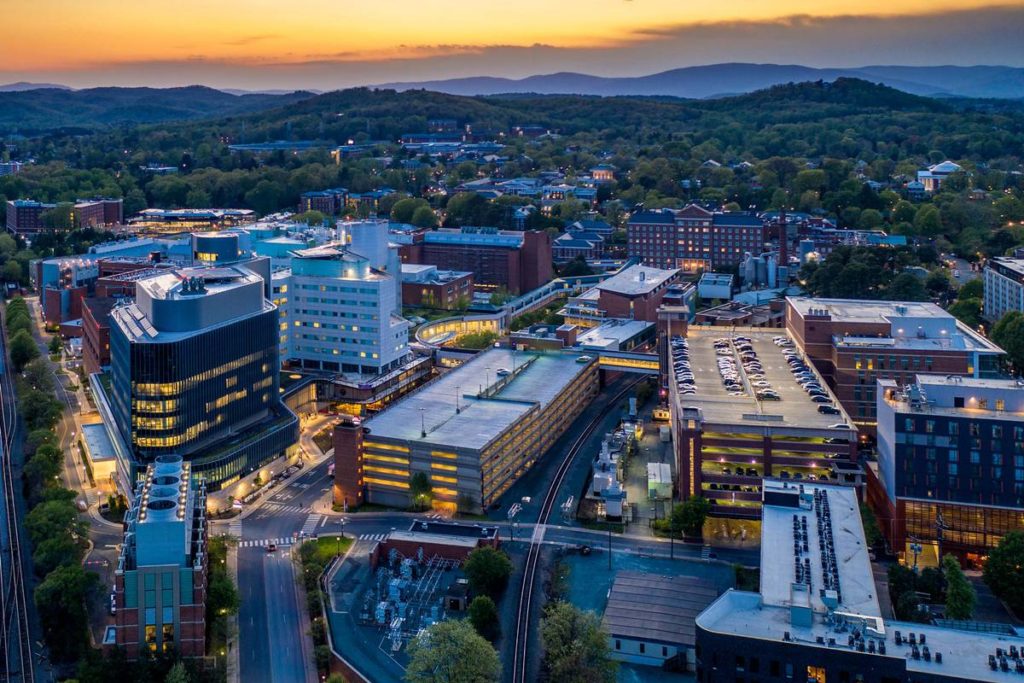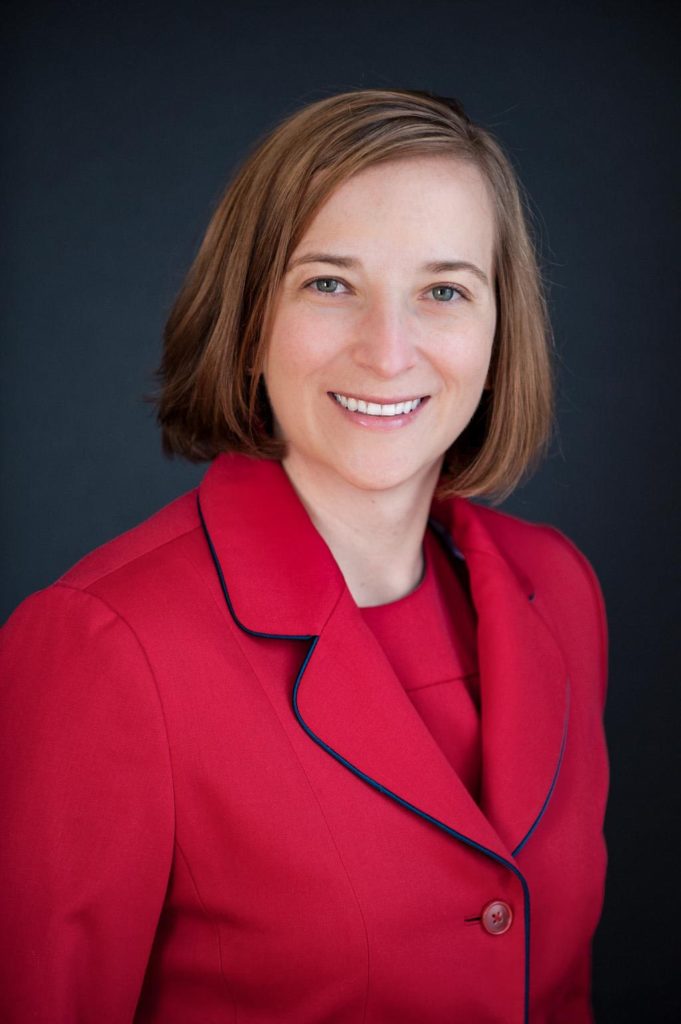
As an academic medical center, UVA Health can draw on resources across the University to help fight the COVID-19 pandemic. (Photo by Sanjay Suchak, University Communications)
When it comes to fighting a pandemic, academic medical centers like the University of Virginia’s have several unique advantages that can be used to help the community, the commonwealth and the country.
For example, UVA Health was able to develop an early in-house COVID-19 test because other research laboratories across the University donated critical supplies like reagents and laboratory technology, circumventing national shortages. Now, even as doctors and nurses are treating COVID-positive patients daily, others remain busy in labs, pursuing vaccines or drug treatments. Still others, across UVA’s 12 schools, are working to record history as it happens, collect data for the present and for posterity, and find creative ways to help their colleagues.

Wendy Horton came to UVA from The Ohio State University and began her new role as COO last month. (Photo courtesy Wendy Horton)
“Academic medical centers truly are where the magic happens in situations like this,” said Wendy Horton, UVA Health’s chief operating officer. “That is what I love most about my job – miracles happen every day; innovation happens every day.”
For Horton, this is week five of seeing those innovations up close at UVA. She joined the UVA Health team in March, coming from The Ohio State University, where she served as chief administrative officer of the College of Medicine and Ohio State University Physicians.
At UVA, her primary responsibility is to make sure that operations across the continuum of care run smoothly. That means keeping necessary supplies in stock, making sure that care providers can adequately staff every unit while getting the support they need, and monitoring safety and quality standards at all times. It also means seeing how UVA, a Level 1 trauma center, can provide support to the commonwealth and the country in the fight against COVID-19.
We spoke with Horton to learn more about how UVA is meeting those needs.
Q. When facing a pandemic, what benefits can an academic medical center offer?
A. Large academic medical centers offer scale and connections to a wider university community with the resources and expertise to make important discoveries and advances. We are learning something new about COVID-19 every day, and academic medical centers like UVA can conduct clinical trials and research to gain and spread that knowledge. And, it’s not just UVA Health. In times like these, the innovation is truly rapid-fire, as people across UVA are focused on this pandemic.
People from the Darden School of Business have reached out with contacts or ideas about how this is impacting our supply chain; pharmacists are compounding hand sanitizer for their colleagues to use; and engineers are working together to 3-D print supplies, something that started in universities and is now becoming mainstream across the country.
Whatever the problem is, you have these great minds available to tackle it, and to cultivate solutions for Virginia and the rest of the nation. What starts here, and at other academic medical centers, will spread outward and help everyone fight this pandemic.
Q. What goes into some of the advances we have seen at UVA, such as the in-house test or clinical trials for potential drugs or other problem-solving?
A. From my perspective, there are several different touch points throughout the day. We have a leadership meeting each morning at 7 a.m., where we are briefed on what has happened overnight in our community, statewide and nationally. It is amazing how much things can change even from when I go to bed to when I wake up. For example, on a recent morning, we learned about a large spike in cases that unfortunately came from one nursing home facility [in nearby Fluvanna County]. As an academic medical center, we can help in cases like that – talking with physicians there, sharing expertise or sending people to help.
Throughout the day, we have other check-ins in the morning and afternoon, to learn about areas of concern and potential solutions. It has been impressive to see teams of people, all on the front lines, listening, swapping concerns and problem-solving in real time. People are constantly brainstorming and helping each other.
Q. How does it change things when the majority of care providers and staff are focused on one big issue like COVID-19?
A. I would say it speeds things up. For example, we recently implemented a new sterilization system allowing us to reuse masks. Normally, we would have conducted research on that system in between other clinical tasks, and probably taken more time to bring it in. Now, we had a team working on that every single day, researching it, acquiring the supplies and getting it set up, tested and ready to go in just a few days.
Then they were onto the next problem. One week, for example, we were focused on surge planning. If cases surge in Charlottesville, what will we need to do? How can we activate different teams of staff, and make sure that they are safe? How can we train people that might need training, get everyone ready?
Q. And research is conducted simultaneously alongside these clinical operations, correct?
A. Absolutely. There is a lot of research going on right now, because we have not experienced something quite like this before. It is important to keep logging notes and data in the moment, so that we can take stock now and come back to this information later, as researchers will be studying this for years.
We have teams collecting data on clinical trials, of course, but also for things like business school case studies, which will be helpful for future students. We also have teams across the University modeling data – trying to determine when the peak might arrive, how social distancing is flattening the curve and what we can expect in the coming weeks and months.
Q. How have staff, faculty and community members been able to help?
A. They have helped in so many ways. First and foremost, so many health care workers are working long, tough hours. Every day when I come in, there are new signs, new chalk messages on the sidewalk, little notes of support. The outpouring from the community has been amazing, and it makes a difference. People have sewn cloth masks that we can use in non-clinical settings, have made mask straps that help keep staff’s ears from getting sore, and have been helping with meals, with child care, with hotel rooms and so much more.
Additionally, people across Grounds have lent their expertise, their advice and their resources, and in some cases, alumni have given extraordinary philanthropic gifts that have allowed us to advance our discoveries more quickly than we would be able to otherwise. Everyone is trying to do what they can, and it has been really, really cool to witness that.
Q. What are the next big challenges or opportunities you are focused on?
A. Initially, we were racing to get prepared, as we were seeing the virus hit in New York and other hotspots. That meant delaying routine care or elective surgeries that could be postponed. Now, we are looking into ways to safely perform some of that care, because there are many non-COVID patients that still have pressing health care needs, or that need help managing chronic conditions – often conditions that put them at higher risk for COVID-19.
Our mission is to care for everyone in our community, and while treating COVID-19 is a huge part of that right now, we also have a responsibility to find ways to safely treat those with other medical concerns. We are expanding our telehealth programs to help meet those needs, and are also working to develop thoughtful, safe ways to provide in-person care and meet the needs of the entire community.
Filed Under: Clinical, Education, Featured, Media Highlights, Research
